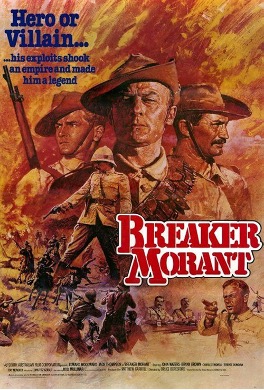

An obscure court martial drama rears its DVD cover once more.
People I meet rarely miss the chance to learn that I was a history major, and prospective historian, before I made Osgoode my home. It is only natural, then, that I might be billed as a creature of the period legal drama, and that the red “O” emblazoned on me was just the excuse my inner cinephile needed to catch up on the great legal dramas, both familiar and new. I often lament that, among this filmic canon, Breaker Morant (1980) is usually forgotten. Perhaps it makes sense: it’s not streaming anywhere—even the once vaunted Blu-Ray is now a relic, after all—and its historical focus on the oft-overlooked Boer War is bound to lend it few active seekers. Beneath what appears to be just another war epic, however, is a courtroom drama more provocative than what its playbill might suggest.
Breaker was part of something of a small renaissance in Australian cinema, a niche moment in time now likely only remembered by those who live Down Under, or perhaps by hoarders of Criterion Collection tapes. The director, Bruce Beresford, situated the early twentieth century war (Canada’s first overseas Imperial war, in fact) within a rather squarely Australian drama. Bereford uses the story of real-life figure Harry “Breaker” Morant (whose biography the film recounts) to launch into questions on Australian identity and its increasingly distant relationship to the British. It’s a particularly Australian tale that nonetheless feels relevant to Canada’s own historical grappling with questions of national identity suspended between the notion of “mother country” and new nationalism. The bulk of the film’s thematic focus, however, is set within the legal-moral questions the audience is confronted with as the set-piece trial, and its background war, unfolds.
Sumptuously shot, the veldt of South Africa takes its natural place as the idyllic backdrop of the film, with unending rolling plains, occasionally watched from afar by imposing mountains beneath streaks of silky clouds. The country’s picturesque width is also the curtain which veils the violence and villainy vested in its seemingly awing beauty. The only language of the land is the .303 bullet. It’s a place which, by 1902, wasn’t estranged from colonial violence, but was now swept in a new British Imperial mission: for gold, land, “civilization,” or some other specious moral objective. The film tells us it doesn’t matter; it points our sights to three Australian officers accused of murder, forlorn and awaiting their khaki-draped superiors to begin the court martial. The open air of the veldt is not here. The suffocating barracks courtroom where much of the film is set contrasts it: Shabby unadorned walls, decorated only by a single framed photograph of Edward VII, enclosing its chamber of law. A supposed cathedral of justice—but this is not a place of salvation.
Captain Willard, the main character of Apocalypse Now (1979), once said that charging soldiers at war with murder was like “handing out speeding tickets at the Indy 500.” This same irony would not be lost on the viewers of Breaker. One hesitates to call any war “civilized” to begin with, but if such a standard somehow existed, then Morant and company’s war is a far departure from it. They were members of the Bushveldt Carbineers: One of several units formed during the war to fight using guerrilla tactics, matching those of the enemy Boers. They exercise a particularly ungoverned role as irregular soldiers, the type tailor-made for rooting out enemies unconventionally, but it seems they’ve breached the limits of their already fragile task. Soon enough, the top brass wants their heads—but the crimes they’re charged with only conceal the underlying intentions of the trial.
The main question threaded throughout the film is if Morant and his peers are truly morally, as well as legally, guilty, considering their overriding conditions. Given the wartime context, the wavelength on which the military justice system operates here is completely unlike the relative normalcy within which we expect courts to run, and every rifle crack and thunderous galloping of a war horse is an omnipresent reminder of this. Do these standards give Morant a pass, then? Is he any better than those around him? Is there not hypocrisy in a large military institution criminalizing soldiers for abiding by rules they set out, actions they encouraged? The film will inevitably provoke its viewers to consider these questions and more. I could very well give my own take—and believe me, I could go on—but what’s the point of a recommendation if I spoil the movie and presuppose how you might see it through my own opinion?
A good legal drama, like any film, ought to be entertaining. But it also ought to seek a higher purpose; it should force us to evaluate that most sacrosanct conception of justice—whether as an idea or institution. Sometimes, it very well demands that it be stretched to its breaking point in the crucible of socially difficult conditions, be it war or otherwise. As you might imagine, Breaker doesn’t give a very pretty portrait of justice: there’s no marbled courtrooms, no impartial judges and witnesses, no lenience or clemency. It’s a grim legal landscape where guilt or innocence are tertiary concerns, superseded by more prejudiced motivations. These conditions may not inspire much optimism, but in the end justice, even at its most compromised junctures, is not straightforward, and the story in Breaker certainly isn’t either. The film’s 1980 poster tagline is spot on: “Hero or villain?” Morant’s legal fate was sealed more than a century ago, but that moral fate remains yours to decide
